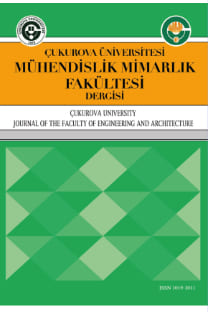Çarpılma Kuvvetleriyle Kaynak Sırasının Optimizasyonu ve Çeşitli Uygulamaların Değerlendirilmesi
Optimization of Welding Sequence by Distortion Forces and Evaluation of Some Applications
___
Masubuchi, K., 1980. Analysis of Welded Structures, Oxford, Pergamon Press.Deng, D., Hidekazu M. and Yukio U., 2002. Theoretical Prediction of Welding Distortion Considering Positioning and the Gap between Parts, The 12th International Offshore and Polar Engineering Conference, International Society of Offshore and Polar Engineers.
Chakravarti, L., Malik M., and Goldak, J., 1986. Prediction of Distortion and Residual Stresses in Panel Welds. Symposium on Computer Modeling of Fabrication Processes and Constitutive Behavior of Metals, Ottawa, Ontario, pp. 547-561.
Bibby, M. J., Goldak, J. A., Szyszkowicz, M.S. and Jefferson, I., 1988. Computational Developments in the Watt Transient Microstructure Algorithm. Modeling of Casting and Welding Processes IV, The Metals Society, 81-91.
Free, A. J. and Goff, R. F. D., 1989. Predicting Residual Stresses in multi-pass Weldments With the Finite Element Method, Computers and Structures, 32(2), 365-378.
Teckiwal, P. and Mazumder, J., 1991. Transient and Residual Thermal Strain-stress Analysis of GMAW, Journal of Engineering Materials and Technology, 113:336-343.
Watt, D. F., Coon, L. Bibby, M. J., Goldak, J. and Henwwod, C., 1988. An Algorithm for Modeling Microstructural Development in Weld Heat Affected Zones (Part A) Reaction Kinetics, Acta. Metall. 36:3029-3035.
Oddy, A. S. Goldak, J. A. and McDill, J. M., 2009. Numerical Analysis of Transformation Plasticity in 3D Finite Element Analysis of Welds. European Journal of Mechanics, A/Solids (3):253-263.
Le Blond, J. B., 1989. Mathematical Modeling of Transformation Plasticity in Steels II: Coupling With Strain Hardening Phenomena, International Journal of Plasticity, 5:573-591.
Das, S., Upadhya, G. C., Kleinosky, M. J. and Tims, M. L., 1993. Finite Element Modeling of a Single-pass GMA Weldment. Modeling of Casting, Welding and Advanced Solidification Processes VI. pp. 593-600, The Minerals & Metals Society.
Guangming, F., 2014. Effect of Boundary Conditions on Residual Stress and Distortion in T-joint Welds, Journal of Constructional Steel Research, 102, 121-135.
Guangming, F., 2016. Influence of the Welding Sequence on Residual Stress and Distortion of Fillet Welded Structures, Marine Structures, 46 30-55.
Bai-Qiao, C., and Soares, C. G., 2016. Effect of Welding Distribution, Distortions and Residual Stress on Stiffened Plates, The International Journal of Advanced Manufacturing Technology, 1-12.
Gannon, L., 2010. Effect of Welding Sequence on Residual Stress and Distortion in Flat-bar Stiffened Plates, Marine Structures, 23.3, 385-404.
Brown S. B., and Song, H., 1992. Finite Element Simulation of Welding of Large Structures, Journal of Engineering for Industry, 114:441-451.
Panagiotis, M., and DeBiccari, A., 1997. Prediction of Welding Distortion, Welding Journal-Including Welding Research Supplement , 76.4 172.
Sikström, F., 2006. 3D-scanning for Weld Distortion Measuring, Instrumentation and Measurement Technology Conference, IMTC2006, Proceedings of the IEEE.
Hackmair, C., Werner, E. and Pönisch, M., 2003. Application of Welding Simulation for Chassis Components Within the Development of Manufacturing Methods, Computational Materials Science, 28.3 540-547.
Voutchkov, I., 2005. Weld Sequence Optimization: the Use of Surrogate Models for Solving Sequential Combinatorial Problems, Computer Methods in Applied Mechanics and Engineering, 194.30, 3535-3551
Junqiang, W., 2016. Predicting Distortion in Butt Welded Plates Using an Equivalent Plane Stress Representation Based on Inherent Shrinkage Volume, Journal of Manufacturing Science and Engineering 138.1, 110-112.
Zargar, S. H., Farahani, M., and Kazem, M., Givi, B., 2015. Numerical and Experimental Investigation on the Effects of Submerged Arc Welding Sequence on the Residual Distortion of the Fillet Welded Plates. Proceedings of the Institution of Mechanical Engineers, Part B: Journal of Engineering Manufacture
Ozcatalbas, Y., and Vural., H. I., 2009. Determination of Optimum Welding Sequence and Distortion Forces in Steel Lattice Beams, Journal of Materials Processing Technology, 209.1 599-604.
Özçatalbaş, Y., 2008. Kaynaklı Birleştirmeli Konstrüksiyonların Çarpılma Eğilimlerinin Belirlenmesi İçin Deneysel Bir Yaklaşım, Gazi Üniversitesi Mühendislik-Mimarlık Fakültesi Dergisi, 23.1, 52-28.
- ISSN: 1019-1011
- Yayın Aralığı: 4
- Başlangıç: 1986
- Yayıncı: ÇUKUROVA ÜNİVERSİTESİ MÜHENDİSLİK FAKÜLTESİ
TiO2 ve AgS Katkılı TiO2 Nanotüp Fotokatalizörlerinin Sentezlenmesi ve Karakterizasyonu
TANER TEKİN, DERYA TEKİN, HAKAN KIZILTAŞ
Meyve Suyu Endüstrisi Atıksuyundan Mikrobiyal Biyopolimer Üretiminin Araştırılması
Ezgi̇ BEZİRHAN ARIKAN, Havva Duygu ÖZSOY, Abdullah EROL, Ayşe İSLAMOĞLU, Derya Nida KAYA, Sevinç ÇAKMAK
GÜLŞAH ÖNER, Hasan Yavuz ÜNAL, Yeliz PEKBEY
A Novel Stacked Monopole Microstrip Antenna for Ultra-Wideband Applications
MUSTAFA BERKAN BİÇER, Ali AKDAĞLI
Casting the Swarms Problem in the Ensembles Context
Çağatay KOK, Seven Burçin ÇELLEK, Çağlar KOŞUN, Serhan ÖZDEMİR
A Novel Application of Chitosan Hydrogel for Eliminate Biofilm Formation on Urethral Catheters
Deniz ISMIK, SEVİL YÜCEL, Melis ÖZGEN, Ceren GENÇ
Pull out Performance of Medical Screws used in Orthopaedic Surgeries
Durmuş Ali BİRCAN, Ahmet ÇETİN
A Hybrid Extreme Learning Machine and its Variant for Stock Price Prediction
MUSTAFA GÖÇKEN, MEHMET ÖZÇALICI, ASLI BORU İPEK, AYŞE TUĞBA DOSDOĞRU
Kondansatör Deşarjli Saplama Kaynağı Kaynak Voltunun Aa6082 Alüminyum Alaşımında Birleşmeye Etkisi
MEHMET ÇAKMAKKAYA, AHMET YÖNETKEN, Ayhan EROL
Çelik Lif ile Güçlendirilmiş Betonlarda Lif Yönünü ve Dağılımını Belirlemede Yeni Bir Yaklaşım
MURAT ÖZTÜRK, Umur Korkut SEVİM, OĞUZHAN AKGÖL, MUHARREM KARAASLAN
